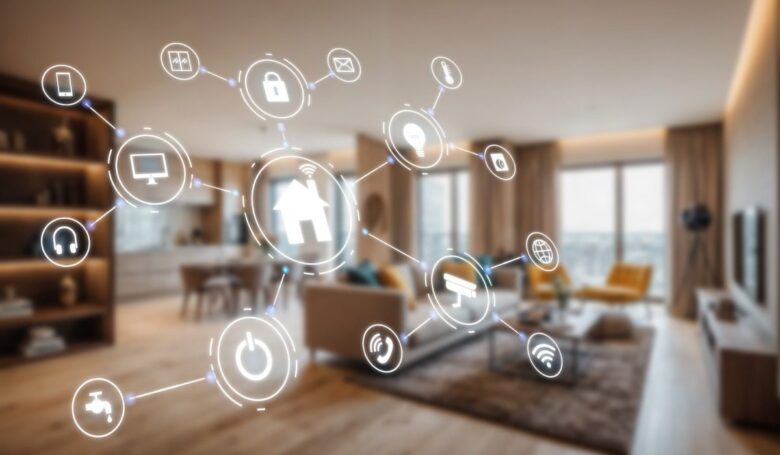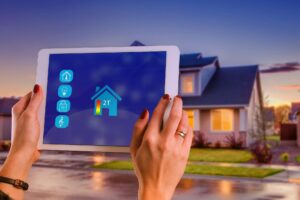Smart technologies are changing the way we live and work, simplifying our lives, automating tasks, and giving us more control over our daily lives. These technologies aim to make life easier and more efficient. Think of smart thermostats, lighting, voice assistants, security cameras, and home appliances, for example. However, as the number of smart devices in the home increases, their management becomes more challenging. By learning how to properly connect and control their various smart devices, homeowners can reap the benefits of a smart environment and avoid problems or wasted time.
Understanding the Smart Device Ecosystem
A single hub or platform controls an ecosystem of interconnected, communicating devices. Wi-Fi, Bluetooth, Zigbee, and Z-Wave are the most common ways smart devices connect and work together. To manage these ecosystems smoothly, you need to understand how they work. Some devices work best with a single smart home app, while others are compatible with multiple platforms. Understanding how your smart devices work together ensures they operate smoothly and reduces the risk of technical difficulties.
Choosing a Central Control Hub or Platform
A central control hub or platform can serve as a single point of control, making it easier to manage multiple smart devices. Amazon Alexa, Google Home, Apple HomeKit, and Samsung SmartThings are some of the most popular platforms. By integrating all smart devices into a single ecosystem, users can control lighting, temperature, security, entertainment, and home appliances with a single app or voice assistant. Choosing a central control hub compatible with most devices eliminates the need to frequently switch between apps, simplifying automation and improving the overall user experience.
Quickly Connect Smart Devices
The steps for connecting smart devices vary depending on the device type and platform. Typically, the first step is to ensure the device is powered on and in pairing mode. Users can then connect to Wi-Fi or the central control hub by following the instructions in the app or manual. A stable network connection and a device within the specified range of the smart home hub improve connection reliability and reduce connection issues. Setting up devices to work together from the start makes management easier and ensures smoother operation.
Device Naming and Organization
Once devices are connected, you can organise them and give them their appropriate names. Giving devices clear and descriptive names, such as “living room light” or “bedroom thermostat”, makes voice commands or apps easier to use and prevents confusion. Users can group devices by room or function, allowing them to control multiple devices simultaneously. For example, you can turn off all the lights in a room with a single command or adjust the thermostat while dimming them to watch a movie. Organisational devices make managing a smart home easier and faster.
Setting Automation Programs and Schedules
One of the best features of smart devices is their ability to automate various tasks. Users can set programs and schedules to have devices work automatically based on time, activity, or weather. For example, lights can turn on automatically at sunset, thermostats can automatically adjust the temperature when no one is home, and coffee makers can automatically brew coffee in the morning. Automation reduces the need for manual operation, making life easier and more energy efficient. By effectively managing their daily tasks, users can maximise the functionality of their smart devices with minimal effort.
Easy Control with Voice Assistants
Voice assistants are crucial for easily controlling smart devices. With platforms like Amazon Alexa, Google Assistant, and Apple Siri, people can control many devices simply by speaking. This hands-free functionality is ideal for cooking, multitasking, or when hands are clumsy. You can use voice commands to adjust lighting, control entertainment systems, monitor cameras, and more. Adding voice assistants to the smart device ecosystem simplifies operation and creates a seamless interactive experience.
Monitoring and Managing Devices Remotely
One of the biggest advantages of modern smart devices is their anytime, anywhere accessibility. Homeowners can monitor and control their devices from anywhere in the world via mobile apps or cloud platforms. This enables individuals to monitor security cameras, adjust the temperature, or switch off forgotten lights, even when they’re not at home. Remote management ensures that smart devices are always active and responsive, giving you peace of mind even when you’re away. It also helps you troubleshoot issues or make changes in real time without disrupting your daily life.
Privacy and Security
Privacy and security are crucial when connecting multiple smart devices. To ensure the security of your smart home ecosystem, ensure your devices always have the latest firmware, use secure and unique passwords, and enable multi-factor authentication where possible. To prevent unauthorised access to your devices, avoid using the default passwords and check them regularly. With proper management, smart devices not only function properly but also protect your personal data. This process also contributes to trust in the technology.
Troubleshooting Common Issues
Even when properly configured, smart devices can occasionally experience connection drops, unresponsive apps, or sync errors. Restarting the device, verifying the network connection, and adhering to the manufacturer’s instructions can resolve most common issues. Keeping devices organized and connected to a stable network reduces the chance of recurring problems. Homeowners can easily manage multiple smart devices without frustration by proactively troubleshooting and maintaining them.
Conclusion
To maximize the convenience and efficiency of today’s technology, you need to be able to easily manage and connect smart devices. Homeowners can create a smooth and efficient smart home experience by understanding the smart home ecosystem, choosing a central control center, intelligently connecting devices, naming and organizing them, setting up automation programs, adding voice assistants, maintaining remote access, ensuring security and reliability, and troubleshooting issues. Seamless management not only makes smart devices easier to use, but also ensures they are energy-efficient, safe, and sustainable. Homeowners can fully realize the benefits of a smart home through careful planning and close attention.
FAQs
1. What is a smart device ecosystem?
A smart device ecosystem refers to a group of interconnected devices that can communicate with each other. You can manage all your devices from one place.
2. Why do my smart devices need a centralised control centre?
A central control centre makes it easier to control all devices, connect them, automate tasks, and reduce the number of times you switch between different apps.
3. How do I connect smart devices to a control centre?
In most cases, the manufacturer’s app or manual will tell you how to turn the device on, put it into pairing mode, and connect it to WiFi or a control centre.
4. Why is it important to name your devices and organise them?
Naming and organising your devices correctly prevents confusion, makes them easier to use, and allows you to control multiple devices simultaneously.
5. Can I use smart devices to automate my daily activities?
Yes, you can set daily activities and schedules to automatically run your devices based on time, activity, or weather conditions.




